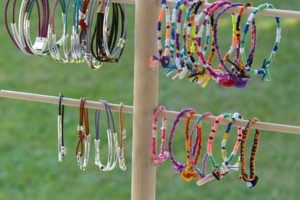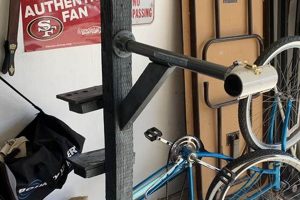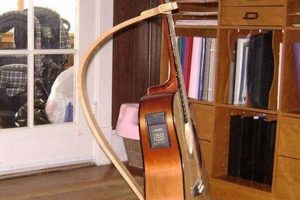Constructing personal frameworks to support targets for firearms practice offers a cost-effective and customizable solution for shooting enthusiasts. These structures, often fabricated from readily available materials, provide a stable platform for target placement at varying distances and elevations.
The advantages of self-made target supports include significant cost savings compared to commercially manufactured options, the ability to tailor the design to specific shooting needs or environments, and the satisfaction of creating a functional item. Historically, individuals have relied on ingenuity and resourcefulness to create such solutions, predating mass-produced alternatives.
The following sections will delve into various designs, materials, construction techniques, and safety considerations relevant to erecting effective and durable target holding apparatuses for shooting sports and practice.
DIY Target Stands for Shooting
Constructing target supports demands careful consideration of safety, stability, and material selection. The following tips provide guidance to ensure a durable and safe platform for shooting practice.
Tip 1: Material Selection is Paramount: Opt for durable materials capable of withstanding projectile impact and environmental conditions. Wood, steel, or composite materials are frequently employed. Treated lumber resists weathering, while steel provides enhanced durability against stray rounds.
Tip 2: Prioritize Stability: A stable base prevents target movement and ensures consistent shot placement. Wide-based designs or anchoring systems contribute to overall stability, particularly in windy conditions. Consider using sandbags or ground stakes for added security.
Tip 3: Implement a Backstop: Safety demands a robust backstop to contain projectiles that miss the target. Backstops can be constructed from earth berms, commercially available ballistic materials, or layered wood. Ensure the backstop extends beyond the target’s perimeter.
Tip 4: Design for Portability (If Required): If mobility is a concern, design the framework for disassembly or easy transport. Modular designs using interlocking components or folding mechanisms facilitate relocation.
Tip 5: Adhere to Safe Shooting Distances: Always maintain a safe distance between the firing line and the target stand, as dictated by the firearm and ammunition being used. Consult firearm safety manuals and range regulations for minimum distance requirements.
Tip 6: Regular Inspection: Consistently inspect the structure for damage (cracks, splinters, rust, etc.). Replace or repair as necessary to maintain safety and structural integrity.
Implementing these tips enhances the safety and effectiveness of self-constructed target supports. Prioritizing stability, material selection, and adherence to safety protocols ensures a reliable and safe shooting environment.
The following sections will address specific designs and construction methodologies for various types of target stands.
1. Material Durability
The lifespan and safety of a self-constructed target support system are directly proportional to the durability of the chosen materials. Substandard materials will degrade rapidly under environmental stress and repeated projectile impacts, leading to structural failure and potential hazards. For example, untreated softwood exposed to prolonged moisture is prone to rot and insect infestation, compromising its load-bearing capacity. Similarly, thin-gauge steel may deform or shatter upon direct impact from high-velocity rounds, creating dangerous shrapnel.
Selecting appropriate materials requires a careful evaluation of intended usage, environmental conditions, and the caliber of firearms being employed. Pressure-treated lumber, for instance, offers superior resistance to weathering and decay compared to untreated wood, making it suitable for outdoor target supports. Alternatively, steel frames constructed from thick-walled tubing provide exceptional strength and resistance to projectile damage, albeit at a higher cost and weight. Composite materials, such as recycled plastics, offer a balance of durability, weather resistance, and ease of fabrication.
In summary, material durability is a non-negotiable factor in the successful creation of self-made target support systems. Compromising on material quality inevitably results in a short-lived, unsafe, and ultimately ineffective structure. A thorough understanding of material properties and their suitability for the intended application is crucial for ensuring a durable and safe shooting experience.
2. Design Stability
The inherent stability of a self-constructed target support directly influences its functionality and safety. An unstable design compromises accuracy by allowing the target to sway or topple, especially in windy conditions or upon projectile impact. This instability negatively affects shooting practice and introduces a potential safety hazard. For example, a simple A-frame stand constructed from lightweight wood without sufficient bracing is prone to collapsing, creating a dangerous situation for shooters and bystanders. Conversely, a well-engineered design incorporating a wide base, reinforced joints, and substantial weight distribution ensures the target remains firmly in place, promoting accurate shot placement and a secure shooting environment.
The selection of appropriate design elements and construction techniques directly translates into improved stability. A triangular base configuration, as opposed to a square or rectangular one, inherently provides greater resistance to tipping. Utilizing cross-bracing within the frame significantly enhances rigidity and prevents lateral movement. Furthermore, incorporating ground anchors or weighting the base with sandbags adds an extra layer of stability, particularly crucial for outdoor applications. An example of a stable design is a H-frame constructed of steel tubing with welded joints and a wide footprint, commonly used in professional shooting ranges. The inherent strength of steel and the robust construction guarantee stability even under heavy use and adverse weather conditions.
In summation, design stability is paramount to the success of self-constructed target supports. It dictates the target’s ability to remain upright and stationary, thereby impacting accuracy, safety, and the overall shooting experience. Neglecting stability in the design phase increases the risk of accidents and diminishes the effectiveness of the shooting practice. A well-considered and executed design, incorporating appropriate materials, construction methods, and stabilization techniques, is essential for creating a safe and reliable target support system.
3. Backstop Integration
Backstop integration is a critical safety component within the context of self-constructed target support systems. The backstop’s primary function is to contain errant projectiles, preventing ricochets and ensuring that bullets or shot do not leave the designated shooting area. The effective integration of a backstop design into the target stand structure minimizes the risk of injury and property damage.
- Material Composition and Ballistic Performance
The materials used in constructing a backstop significantly impact its ability to absorb and stop projectiles. Common materials include compacted earth, layered wood, steel plates, and commercially available ballistic rubber. The ballistic performance of each material varies depending on the firearm caliber and ammunition type used. A backstop designed for low-velocity rounds may be inadequate for high-powered rifles, leading to penetration and failure. Therefore, careful consideration of material selection based on intended usage is paramount.
- Angle and Surface Area
The angle of the backstop and its surface area influence projectile deflection and containment. An angled backstop directs projectiles downwards into the ground, reducing the risk of ricochets. A larger surface area ensures that the backstop adequately covers the entire target area, accommodating potential misses. Insufficient surface area can result in projectiles escaping the confines of the backstop, negating its safety function. The geometry of the backstop is therefore a vital element in its effectiveness.
- Structural Integrity and Support
The structural integrity of the backstop and its integration with the target support framework are crucial for maintaining its effectiveness over time. A poorly constructed backstop may collapse under the repeated impact of projectiles, rendering it useless. The support structure must be capable of withstanding the weight of the backstop material and the force of projectile impacts. Adequate bracing and reinforcement are necessary to ensure the long-term stability of the entire system.
- Distance and Placement Relative to Target Stand
The distance of the backstop from the target and its placement relative to the target stand are key considerations. The backstop should be close enough to the target to catch errant shots but far enough away to allow for safe operation and prevent fragmentation from impacting the shooter. Correct placement ensures complete coverage of the intended impact zone, while maintaining a safe distance that minimizes the risk of backsplash or debris.
The facets of backstop integration highlight the importance of a comprehensive approach to safety in self-constructed target stands. Integrating a properly designed and constructed backstop enhances safety. All components must work harmoniously to contain projectiles and minimize the risk of injury or damage.
4. Portability Options
The ability to easily transport target supports is a significant consideration for many shooting enthusiasts. Self-constructed target stands offer a range of portability options, providing flexibility in adapting to diverse shooting locations and storage constraints. Designs can be tailored to prioritize ease of movement without sacrificing stability and safety.
- Modular Design and Disassembly
Constructing target stands with modular components facilitates disassembly and reassembly. This approach allows the user to break down the structure into smaller, more manageable pieces for transport. Example: A frame constructed from interconnected PVC pipes can be quickly disassembled and packed into a compact form. The implications include convenient storage and transport in vehicles with limited cargo space.
- Folding Mechanisms
Incorporating folding mechanisms into the design enables the target stand to collapse into a compact configuration. Hinges and pivoting joints allow for easy folding and unfolding, reducing the overall footprint during transport and storage. Example: An A-frame stand with hinged legs can be folded flat for convenient carrying. The implication is rapid setup and takedown at the shooting location, saving time and effort.
- Lightweight Materials
Selecting lightweight materials, such as aluminum or thin-walled steel tubing, reduces the overall weight of the target stand, enhancing portability. While maintaining structural integrity, these materials offer a significant weight advantage compared to heavier alternatives like solid wood or thick steel. Example: A target stand constructed from aluminum tubing is significantly lighter than one made from solid wood, making it easier to carry over long distances. The implication is reduced physical strain and improved maneuverability during transport.
- Integrated Carrying Handles or Wheels
Adding integrated carrying handles or wheels to the design further enhances portability. Handles provide a convenient grip for lifting and carrying the target stand, while wheels allow for easy rolling over various terrains. Example: A target stand with integrated carrying handles can be easily lifted and transported by one or two individuals. A target stand with attached wheels can be rolled across a field or parking lot with minimal effort. The implications include improved ergonomics and reduced physical exertion during transport.
The selection and implementation of appropriate portability options are integral to the practicality and usability of self-constructed target supports. By carefully considering factors such as modularity, folding mechanisms, material weight, and integrated carrying features, individuals can create target stands that are both functional and easily transported to various shooting locations.
5. Safety Distances
Maintaining appropriate safety distances is paramount when utilizing self-constructed target supports. These distances serve as a critical safeguard against potential hazards associated with firearms practice, mitigating the risk of injury or property damage.
- Minimum Firing Line Distances
Established minimum distances exist between the firing line and the target, varying based on firearm type and projectile velocity. These distances account for potential bullet trajectory deviations and fragmentation patterns. Exceeding these distances reduces the likelihood of a shooter being struck by ricocheting projectiles. Failure to adhere to minimum firing line distances dramatically increases the risk of serious injury when employing self-made target holders.
- Lateral Safety Zones
Lateral safety zones, extending beyond the target’s width, prevent projectiles from leaving the designated shooting area. These zones account for inaccurate shots or projectile deflections. Constructing self-made target holders necessitates defining and enforcing these lateral zones to safeguard bystanders and surrounding property. The absence of lateral safety zones creates a dangerous environment, where errant projectiles can cause unintended harm.
- Backstop Proximity and Composition
The proximity of the backstop to the target and its material composition directly affect projectile containment. The backstop should be positioned at a distance that allows for effective projectile capture while preventing fragmentation from reaching the firing line. Self-constructed target holders should be paired with a backstop of sufficient size and material to effectively stop projectiles fired from the intended firearms. A poorly positioned or inadequately constructed backstop compromises safety, increasing the risk of projectile escape.
- Observer and Bystander Distances
Maintaining adequate separation between observers, bystanders, and the active firing line is crucial. These distances minimize the risk of accidental injury from stray projectiles or debris. Self-constructed target holders require careful consideration of observer and bystander positioning to ensure their safety. Failure to maintain safe distances from the firing line places individuals at unnecessary risk.
Compliance with established safety distance protocols is non-negotiable when engaging in firearms practice with self-built target supports. These distances, encompassing firing lines, lateral zones, backstop proximity, and observer positioning, collectively contribute to a safe and controlled shooting environment. Neglecting these guidelines introduces unacceptable risks, potentially leading to severe consequences.
6. Structural Integrity
The concept of structural integrity is fundamental to the safe and effective use of self-constructed target supports. Structural integrity refers to the ability of a structure to withstand applied loads and environmental conditions without failing or deforming excessively. In the context of target stands, this encompasses resistance to projectile impacts, wind forces, and the weight of the target itself. A lack of structural integrity in a target stand can lead to catastrophic failure, posing a significant safety risk to shooters and bystanders. A rudimentary stand constructed with flimsy materials, for example, may collapse under the force of a stray bullet, potentially sending debris flying or causing the target to fall unpredictably.
Several factors influence the structural integrity of a self-built target support. Material selection plays a crucial role; the use of durable materials such as steel or pressure-treated lumber ensures greater resistance to damage and decay. Design considerations are equally important; a well-engineered design incorporates triangulation, bracing, and a stable base to distribute loads effectively and prevent buckling or overturning. Construction techniques, such as proper welding or secure fastening, contribute to the overall strength and stability of the structure. For instance, a steel target stand with poorly executed welds may exhibit points of weakness, increasing the likelihood of failure under stress. Regular inspection and maintenance are also essential to detect and address any signs of degradation, such as rust, cracks, or loose connections.
In summary, structural integrity is a non-negotiable aspect of safe and reliable target support systems. A thorough understanding of material properties, design principles, and construction techniques is essential for creating target stands that can withstand the rigors of shooting practice. Prioritizing structural integrity mitigates the risk of accidents, enhances the accuracy of shooting practice, and ultimately contributes to a safer and more enjoyable shooting experience.
Frequently Asked Questions
The following section addresses common inquiries regarding the construction and usage of self-made target support systems for shooting practice. The information presented aims to clarify misconceptions and provide guidance for ensuring safe and effective target presentation.
Question 1: What materials are most suitable for constructing a durable target stand?
The selection of materials depends on factors such as budget, intended usage, and environmental conditions. Treated lumber offers a cost-effective option for outdoor use, while steel provides superior durability against projectile impact. Composite materials offer a balance of durability and weather resistance. The chosen material should be capable of withstanding repeated use and exposure to the elements.
Question 2: How can I ensure the stability of my target stand, particularly in windy conditions?
Stability is achieved through a combination of design elements and reinforcement techniques. A wide base provides a stable foundation, while cross-bracing enhances rigidity. Ground anchors, sandbags, or weighted bases further improve stability, particularly in windy environments. The design should resist tipping or movement due to wind or projectile impact.
Question 3: What constitutes an adequate backstop for containing projectiles?
An adequate backstop effectively captures projectiles and prevents ricochets. The composition and size of the backstop should be appropriate for the firearm caliber and ammunition being used. Common backstop materials include compacted earth, layered wood, and ballistic rubber. The backstop should extend beyond the target’s perimeter to accommodate potential misses.
Question 4: Is it possible to construct a target stand that is both durable and portable?
Yes, by employing modular designs and lightweight materials. Modular designs allow for disassembly and reassembly, facilitating transport. Lightweight materials, such as aluminum or thin-walled steel, reduce the overall weight of the stand. Integrated carrying handles or wheels further enhance portability.
Question 5: What safety precautions should be observed when using a self-constructed target stand?
Adherence to established safety protocols is paramount. Maintain safe firing distances, define lateral safety zones, and ensure a secure backstop. Wear appropriate eye and ear protection. Regularly inspect the target stand for damage or degradation, and address any issues promptly.
Question 6: Are there any legal regulations pertaining to the construction and use of target stands?
Regulations regarding firearms usage and target practice vary by jurisdiction. It is incumbent upon the individual to be familiar with and comply with all applicable federal, state, and local laws. Contact local law enforcement or relevant regulatory agencies for clarification on specific requirements.
This FAQ section underscores the critical importance of prioritizing safety, stability, and adherence to applicable regulations when constructing and using self-made target support systems.
The next section will explore specific designs and construction methodologies for various types of target stands.
Conclusion
This exposition has detailed various aspects of diy target stands for shooting, emphasizing safety, durability, and functionality. Topics included material selection, design stability, backstop integration, portability, safety distances, and structural integrity. A thorough understanding of these considerations is vital for constructing effective and safe shooting practice apparatuses.
The information presented offers a foundation for informed decision-making. Responsible application of these principles fosters a secure and productive shooting environment. Continued adherence to best practices will improve the quality and safety of shooting activities.







